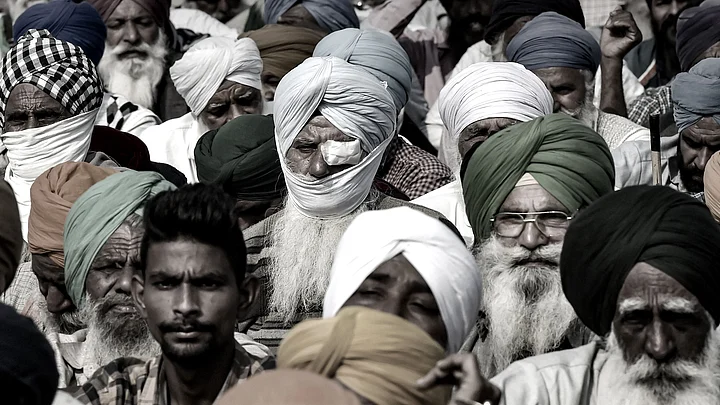After what they call ‘a smear campaign’ against Shaheen Bagh protesters, lakhs of farmers from Punjab, Haryana, Rajasthan, Uttar Pradesh and other parts of the country have a clear strategy. They have stepped up their efforts to not let their dissent be misconstrued, misinterpreted or politicised by ‘Godi Media’ – an infamous term used to describe a group of mainstream TV news channels who, in the farmers’ opinion, report in a way which favours the central government.
The protests which initially sparked in Punjab in September didn’t receive much media viewership. And when they did, the ‘fabricated’ accusations against farmers were aplenty – of being ‘Khalistan supporters’ or being backed by the Opposition or being influenced by lobbyists and the ‘award wapsi returns gang’.
To counter this allegedly biased narrative, farmers are mobilising social media on a never-before-seen scale, with protesters – especially the youth – taking it upon themselves to create awareness about the challenges faced by farmers. And what’s helping them is alternative media – independent activists, photographers, YouTubers and Instagrammers – to put forth their concerns without any bias or misconstruction of motive.
Alternative Media Bring Out Real Stories, Counter Propaganda
“I don’t think any protests have been represented well by mainstream media”, 19-year-old Vibhu Grover, who has 16,000 followers on Instagram, tells The Quint.
“This is the anger of the last three months, and for the last 30 to 40 years as well. This is the biggest movement for agricultural reforms after Independence. They are very angry with the media and the government for ignoring them but they are the most lovely people I’ve met,” Grover, who has covered the protests from its initial days in Punjab, adds.
“They will stop you to give you food and chai. I don’t think someone against the country will help others so much. There are ragpickers and their children who come and eat at the community langar,” Akshay Kapoor, a 26-year-old photographer with close to 19,000 followers on Instagram, tells The Quint.
“Reporting this is my duty since I have my camera. Even if it reaches a 100 people, I am making a difference and it’s how I can help. This is my art and this is my activism.”Akshay Kapoor
By posting live footage from the sites of the protests, Kapoor has ensured that the spotlight stays on the farmers and their demands to scrap the Centre’s new farm laws.
The footage these social media influencers post to combat misinformation and propaganda can vary from videos of farmers singing songs of revolution to them ensuring consistent food supply for protesters.
“Through my stories, I want to document the real stories of the protesters and try to create awareness against propaganda,” says Mohammad Zuber, an activist and Instagram influencer with almost 27,000 followers, who has actively been posting in solidarity with the protests.
Anger On Being Vilified By The Media
The farmers have found a representative from each protesting group to speak to the media to ensure their views are not misrepresented, explains Kapoor.
“They ask which news channel/media house you are from. They are comfortable speaking to independent activists and YouTubers. But if they see an Aaj Tak mic, they won’t come to you.”Akshay Kapoor
The ‘Godi Media’, however, seems to have failed to vilify the farmers, according to Groverr.
“They know they can’t vilify the protesters and get away with it like they did with Shaheen Bagh protesters because of the bigotry of the country against Muslims,” he says. “Years of oppression and abuse of power is the trigger behind these protests. These protests are not just triggered by what’s happening now or by the current political party. The media has always been the propaganda tool for any political party in power.”
Prabhjit Singh, who has reported extensively on Punjab and is a senior reporter at The Caravan, adds, “The issues that the Punjab farmers faced have been buried in Punjabi papers, in Maharashtra in Marathi papers, and so on and so forth. It has never come out in the national forum because newspapers want stenographers, not reporters. Reporters sent on ground are often crime reporters, and not agriculture reporters, and they often don’t know the context of the protests.”
“There were messages on Facebook and Twitter that they need more and more communication in English. ‘Let’s start conversing and countering the IT BJP cells.’ ‘‘Godi Media’ is misrepresenting our protests across the country.’ People from various walks of life formed WhatsApp groups and came up with a hashtag to counter the misinformation.”Prabhjit Singh
Unnecessary Politicisation Of Farmers’ Agitation
Twenty-two-year-old Ismat Ara, a journalist with The Wire, who has been reporting on the protests, has almost 19,000 followers on Twitter.
“In a democracy, protests should be considered as normal as anything else as it is a way to register people’s dissent. But in our country, our first response to a protest is to ask if the protests are being funded by any political party or to question the protesters' credentials, which is unfair,” Ara tells The Quint.
Kapoor reiterates Ara’s point of view by saying, “They don’t let politicians take over the stage. They are not Khalistan supporters, they have not been influenced by any political parties. It is a people’s movement. Every protester on site comes from a farmer’s family. They have told their families they won’t return till this is resolved. These are common people”.
(At The Quint, we question everything. Play an active role in shaping our journalism by becoming a member today.)
